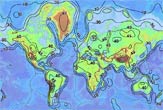
A team of scientists will embark on a voyage next week to study an “open wound” on the Atlantic seafloor where the Earth’s deep interior lies exposed without any crust covering.
The lesion is located mid-way between the Cape Verdes Islands and the Caribbean in the Atlantic Ocean [image]. It lies nearly 2 miles beneath the ocean surface and extends over thousands of square kilometers.
“It’s quite a substantial area,” said Chris MacLeod, a marine geologist at Cardiff University in the UK, who will be part of the expedition.
Earth’s tough skin
An outer crust of varying thicknesses covers most of the surface of the Earth like a shell. The crust is about 20 miles deep beneath continents and about 4 miles deep under the ocean floor. The Earth’s middle layer is called the mantle; it is heated by the Earth’s core and is much hotter and softer than the crust.
101 Amazing Earth Facts
Earth’s crust is constantly being destroyed and created, and this cycle of destruction and renewal occurs faster with ocean crust than with continental crust. New ocean floor crust forms at seams on the Earth’s surface, called mid-oceanic ridges, where the planet’s tectonic plates meet and where molten magma rises up from the planet’s upper mantle.
The upwelling drives seafloor spreading, which is the movement of two oceanic plates away from each other. Oceanic crust is destroyed at so-called subduction zones where two plates collide and typically the denser one slips beneath another plate.
Get the world’s most fascinating discoveries delivered straight to your inbox.
This is how scientists think it works, but areas of exposed mantle on the Earth’s surface aren’t easily explained by this theory. They are regions “where this process seems to have gone wrong somehow,” MacLeod said. “There’s no crust formed, and instead we’ve got mantle—which is normally in the deep Earth—on the seafloor.”
- Top 10 Ways to Destroy Earth
Really nail it down
Scientists have known about such anomalies for years, but it is only within the past decade that they have actively begun investigating them, MacLeod said.
In 2001, MacLeod was part of a team that visited the Atlantic Ocean gash. “We ended up answering one or two questions but posing many more,” he said. “What we’re going to do with this expedition is try to really nail down what’s happening.”
There are two popular hypotheses about how these holes in the Earth’s crust form. “One is that the original volcanic crust did form but that it’s been ripped away by a huge rupture,” MacLeod told LiveScience.
MacLeod likens this process to stretching a person’s skin until it ruptures, exposing the flesh underneath. “You take the crust and you stretch it and you pull it and pull it until it breaks,” he said.
The other idea purports that somehow the area of exposed mantle was never covered by a magma crust in the first place.
A rare opportunity
Regardless of how they formed, the exposed mantle provides scientists with a rare opportunity to study the Earth’s rocky innards. Many attempts to drill deep into the planet barely get past the crust.
“One of our objectives now that we’ve got direct access to these mantle rocks is to try and look at their internal properties and try to find out about the deep Earth process that we can’t get at directly,” MacLeod said in a telephone interview.
Getting equipment down onto the seafloor where the exposed mantle is will be difficult, however. “It’s a very hazardous, very unforgiving environment,” he said. “There are very steep slopes and huge pressures. So getting samples back from these areas is challenging still.”
The team of researchers, led by Roger Searle of Durham University, will begin traveling to the site on March 5, 2007 aboard the new UK research ship “RSS James Cook.” Over the course of about six weeks, the team will use sonar to image the seafloor and a robotic seabed drill to collect rock cores.
- Hole Drilled to Bottom of Earth's Crust
- Giant Slab of Earth's Crust Found Near Core
- Ancient Impact Turned Part of Earth Inside-Out
- Breakthrough: New Way to Peek Inside Earth
- Wax World: Modeling the Moving Earth
The crust thickness averages about 18 miles (30 kilometers) under the continents, but is only about 3 miles (5 kilometers) under the oceans. It is light and brittle and can break. In fact it's fractured into more than a dozen major plates and several minor ones. It is where most earthquakes originate.
The mantle is more flexible – it flows instead of fractures. It extends down to about 1,800 miles (2,900 kilometers) below the surface.
The core consists of a solid inner core and a fluid outer core. The fluid contains iron, which, as it moves, generates the Earth’s magnetic field. The crust and upper mantle form the lithosphere, which is broken up into several plates that float on top of the hot molten mantle below.
SOURCE: LiveScience reporting



